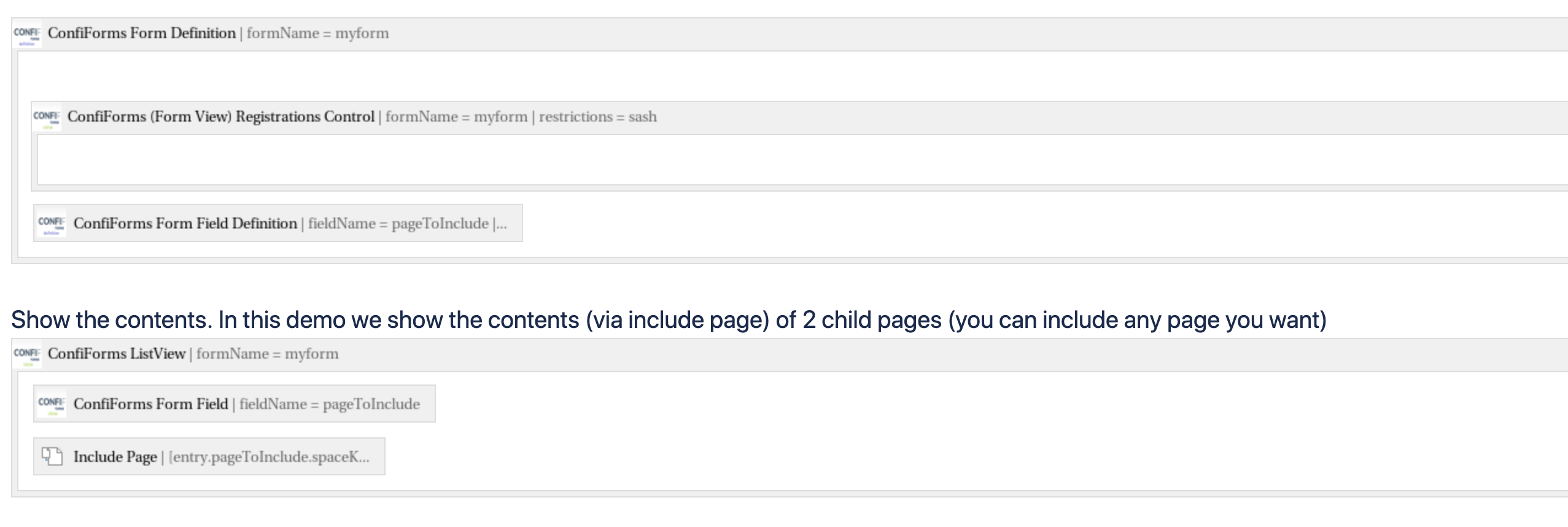Playground and DEMO space
This is a playground and demo space for ConfiForms and ConfiDoc addons developed and supported by Vertuna LLC
Most pages provide a storage format for the demo, so you can use the free add-on from Atlassian Confluence Source Editor (or through the bundled in ConfiForms storage editor) to import this configuration into your Confluence and see it in action
To import examples from the storage format on Confluence Cloud please see this page
Please note, all the examples here are provided without any obligation and may or may not be incomplete or may have bugs, and we provide NO SUPPORT for these examples and demos.
Background
In this demo we demonstrate how to use ConfiForms data as parameters for Atlassian Include page macro
You can see a complete configuration for you to import on the bottom of the page
Here is how it looks like in the editor
The tricky part is the set up of the "Include Page" macro and you need to do it using Confluence source editor, as otherwise it does not accept dynamic parameters
The configuration for this macro should loom like this (assuming your information about what page to include is stored in "pageToInclude" ConfiForms Field of "Page/Blogpost" type)
<ac:structured-macro ac:macro-id="b728042f-5210-47ca-a201-0927375638a9" ac:name="include" ac:schema-version="1"> <ac:parameter ac:name=""> <ac:link> <ri:page ri:content-title="[entry.pageToInclude.title]" ri:space-key="[entry.pageToInclude.spaceKey]"/> </ac:link> </ac:parameter> </ac:structured-macro>
You can see we use "pageToInclude" objects properties to get the values for page title and space key.
See Accessing page properties for more details on which properties are available for each field type in ConfiForms
Realtime example
We have 2 records stored in the form at the moment
|
Page to include |
|---|
| TEST : Include page 1 |
| TEST : Include page 2 |
and we will show the contents of these pages with the help of Include Page macro
Show the contents. In this demo we show the contents (via include page) of 2 child pages (you can include any page you want)
Some dummy info block...
| This | is | demo |
|---|---|---|
| Nothing | else | ... |
Children pages
Storage format (configuration) for the demo
<ac:structured-macro ac:macro-id="f7bd459e-85e2-499e-9127-89684ea0e5ad" ac:name="confiform" ac:schema-version="1"> <ac:parameter ac:name="formName">myform</ac:parameter> <ac:rich-text-body> <ac:structured-macro ac:macro-id="096bc0a3-c584-4a1f-9db3-b7a73be4a592" ac:name="confiform-entry-register" ac:schema-version="1"> <ac:parameter ac:name="formName">myform</ac:parameter> <ac:parameter ac:name="atlassian-macro-output-type">INLINE</ac:parameter> <ac:rich-text-body> <p> <br/> </p> </ac:rich-text-body> </ac:structured-macro> <p> <ac:structured-macro ac:macro-id="b07876a3-36b9-4c3f-8294-690d83f01ec8" ac:name="confiform-field-definition" ac:schema-version="1"> <ac:parameter ac:name="fieldName">pageToInclude</ac:parameter> <ac:parameter ac:name="fieldLabel">Page to include</ac:parameter> <ac:parameter ac:name="extras">TEST</ac:parameter> <ac:parameter ac:name="type">page</ac:parameter> </ac:structured-macro> </p> </ac:rich-text-body> </ac:structured-macro> <p> <br/> </p> <h2>Show the contents. In this demo we show the contents (via include page) of 2 child pages (you can include any page you want)</h2> <ac:structured-macro ac:macro-id="826c226a-5bbc-40f5-bf85-f837aa086a16" ac:name="confiform-list" ac:schema-version="1"> <ac:parameter ac:name="formName">myform</ac:parameter> <ac:rich-text-body> <p> <ac:structured-macro ac:macro-id="7edd88ce-6a0d-4a38-9bf0-2070abe9207f" ac:name="confiform-field" ac:schema-version="1"> <ac:parameter ac:name="fieldName">pageToInclude</ac:parameter> </ac:structured-macro> </p> <p> <ac:structured-macro ac:macro-id="b728042f-5210-47ca-a201-0927375638a9" ac:name="include" ac:schema-version="1"> <ac:parameter ac:name=""> <ac:link> <ri:page ri:content-title="[entry.pageToInclude.title]" ri:space-key="[entry.pageToInclude.spaceKey]"/> </ac:link> </ac:parameter> </ac:structured-macro> </p> </ac:rich-text-body> </ac:structured-macro>
